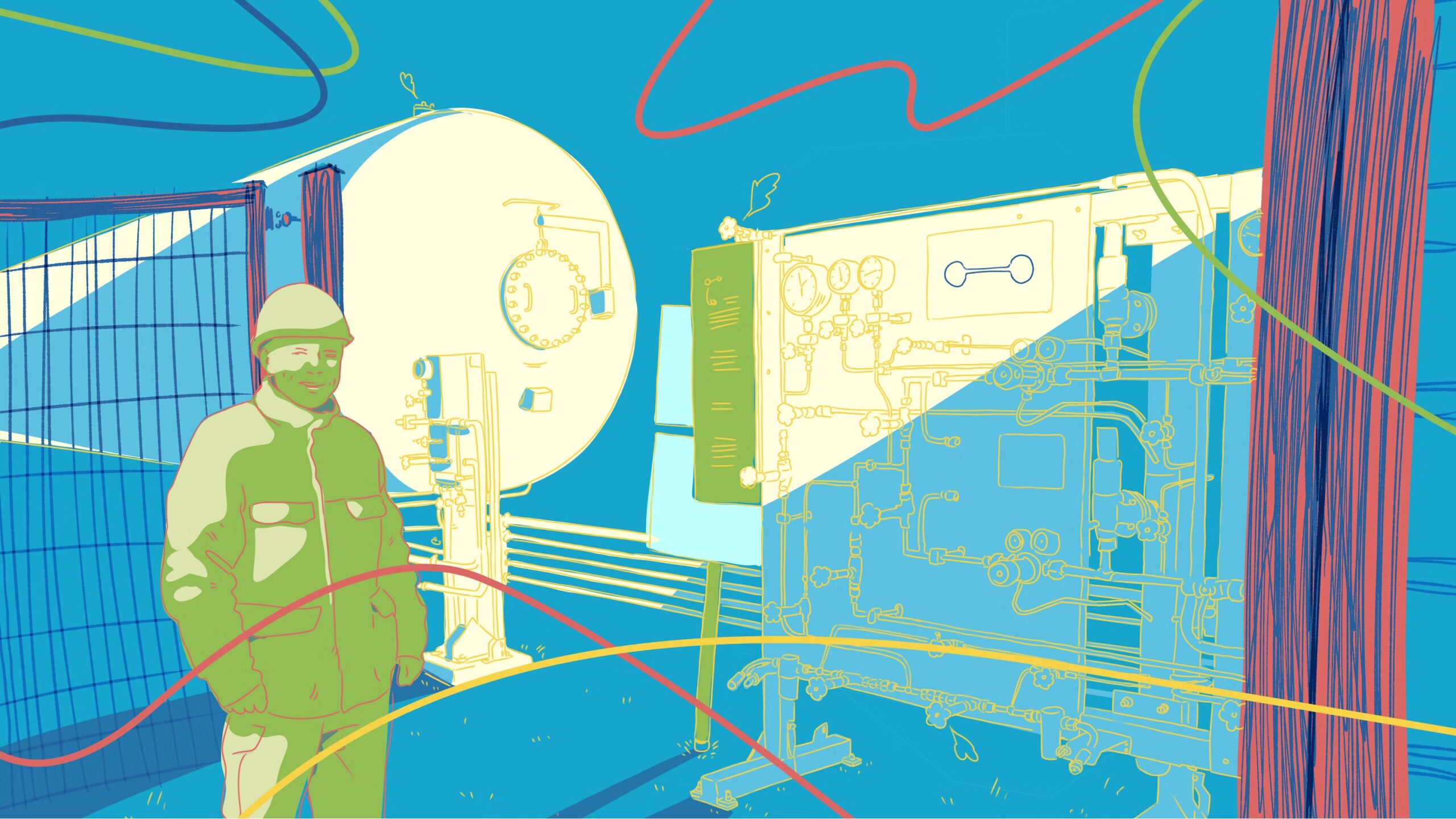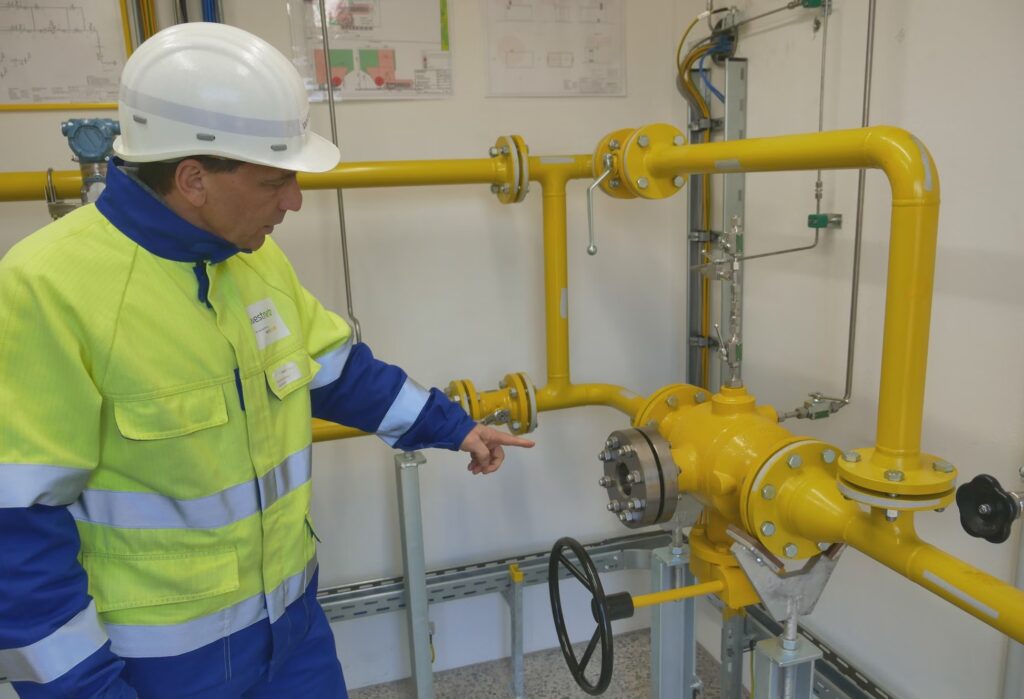
Will hydrogen be the answer to Germany’s future energy needs?
- Written by Felix Austen
- Illustration by Frauke Berger
Heating, driving, storing electricity: Hydrogen could replace oil, gas and coal in a completely climate-neutral way. The fact that this will probably not happen is due to a better alternative.
Read this article in German in Perspective Daily.
Hydrogen is a volatile gas. No one has ever seen this invisible element with their naked eye. With the right technology, however, we can make it visible in one way or another when we generate heat, electricity, motion or much more from it.
It is a similar story with the “hydrogen economy”, an energy system of the future based on hydrogen. There are already many small building blocks for it – fuel cells, pipelines and hydrogen heaters. We can look at them, test them and improve them – but how will the pieces come together one day to form a whole? No one really knows for sure.
Hardly anyone doubts that hydrogen will play a greater role in the future. And yet, to put it simply, there are two camps in the debate: Hydrogen optimists and hydrogen skeptics.
The first group sees almost sheer endless potential in hydrogen. They are convinced that in Germany, people will soon be heating their homes and refueling their trains, cars and airplanes with hydrogen. The country’s industrial ovens, chemical facilities and parts of the power supply are also to be based on hydrogen.
The energy carrier is expected to take over all the diverse tasks that are still performed by oil, gas and coal today - and many more beyond that.
On the other side are the skeptics. They also believe in a future with hydrogen – but on a much more manageable scale. They see hydrogen as a supplement and think it makes sense above all where there is no better alternative.
The way that the hydrogen economy materializes in Germany, Europe and ultimately the world will depend on many factors: technological advances, political decisions and money. One thing is clear: The hydrogen economy is coming. And in a globalized world, it will not stop at the borders of nation states. Rather, its energy flows will extend around the globe, through pipelines and via shipping routes, across gas, electricity and road networks.
What does the future of hydrogen look like in Germany? I discussed this with two experts – one from the optimist camp and one skeptic. I also took a look at a pilot project that is testing how the German gas grid could gradually be converted to hydrogen and that would take.
The technology runs "without a hitch"
It’s a gray day in North Rhine-Westphalia, with only the occasional patch of sunshine flitting across the roads and fields. On the outskirts of the small town of Holzwickede, in an industrial area crammed between a highway and Dortmund Airport, Carsten Stabenau nevertheless welcomes me with a friendly face. As an innovation management officer, he oversees hydrogen pilot projects for Westnetz GmbH. Projects like the one at whose gateway he is meeting me today. Stabenau wears a white safety helmet on his head and has a second one for me in his hand.
In the “H2HoWi” project, Westnetz AG, one of Germany’s largest distribution network operators, is testing how gas distribution networks can be converted to pure hydrogen. To do this, the subsidiary of Westenergie AG has disconnected 500 meters of pipes from the distribution network and connected them to the large white hydrogen tank that stands here fenced in with a few other technical installations. Instead of using Russian or Dutch natural gas, three participating companies in the industrial area have been heating with the hydrogen produced here since last fall. The aim of the project is to find out how pipes, valves, pressure regulators and other elements of the gas network cope with the new transport material.
Within the scope of this test, the hydrogen flows almost entirely by itself: If the level in the hydrogen tank falls below a certain level, an electronic device automatically orders replenishment from the supplier. Shortly afterwards, a truck arrives with its delivery and refills the tank. The hydrogen used also comes from North Rhine-Westphalia and is produced using renewable electricity. “To sum up already: It’s running trouble-free, operation is not a problem,” says Stabenau.
With the project, Westnetz GmbH wants to show that converting Germany’s gas infrastructure to accomodate hydrogen is technically feasible.
"We assume that we can use 95% to 98% of our natural gas distribution network to transport hydrogen," says Stabenau, who is now primarily involved with hydrogen projects. "I'm having a lot of fun with this"
And there’s a good reason for that: the prospect of a hydrogen economy has given a new perspective to an industry whose days already seemed numbered. “Our colleagues are looking forward to working on something new.” First climate change, then Russia’s attack on Ukraine and the end of Russian gas supplies have fueled discussions about saying goodbye to natural gas. The industry is unsettled, and quite a few see hydrogen as the salvation of their guild.
But how could such a major conversion of all German gas networks to hydrogen work in concrete terms? After all, hundreds of thousands of customers rely on the flow of energy every day. “This is a huge upheaval,” says Stabenau as we stroll around the large tank.

How the gas to hydrogen conversion will work - bit by bit
"On paper, we went through the process of converting from natural gas to 100% hydrogen to figure out how many households you can do per day. This is done gradually, converting street by street - not thousands of customers per day."
Carsten Stabenau
From the grid side, as described, this is easily feasible. The bottleneck starts at the replacement of the end applications- in other words, the heating systems.
Although most of the gas boilers installed today can handle a blend of hydrogen, they do not work with pure hydrogen, which is why the heating systems and other gas consumers in these sectors will have to be replaced or converted. The problem is that hydrogen heating is still very expensive today.
Stabenau sees a possible way out of this in newly developed natural gas boilers that could later be converted to hydrogen with the help of a conversion kit. This would make it possible to prepare for the switch to hydrogen at an early stage.
So operators like Westnetz GmbH have plans for a nationwide hydrogen supply in the drawer. But will it ever get that far?
The dark side of hydrogen
Jens Clausen has – to put it mildly – doubts about that. The mechanical engineer is co-founder of the Borderstep Institute, an independent and non-profit research institute that advises companies, associations and politicians on sustainability issues. Clausen has been working on hydrogen for years and has co-authored several publications on hydrogen for Scientists for Future, among others. He sees many reasons why hydrogen is unlikely to catch on in a major way and why it cannot offer a one-to-one replacement for natural gas in our grids. For him, too, it is not so much a question of technology:
"It's not even a question of whether you can somehow heat or drive a car with hydrogen - you can. But given the terrible efficiency of the technology, it makes absolutely no sense to want to do that. Especially when hydrogen is in short supply. And it will remain so for the foreseeable future."
Jens Clausen, mechanical engineer and co-founder of the Borderstep Institute
Clausen is alluding to the energy losses that always occur when hydrogen is extracted from electricity and then converted back again. Currently, in this case, just under half of the original energy remains. Imagine you want to freeze a soup to make it durable – but when you thaw it out, only half is left.
Future technological advances in hydrogen technology could reduce these losses even further. But in terms of energy – and thus also from a financial perspective – it will always be advantageous to consume the electricity directly rather than to convert it back and forth at great expense. In other words, to eat the soup while it’s still steaming.
Wherever there are good alternatives to hydrogen that use electricity as an energy source, they have a clear advantage. Most experts agree on this. And this is definitely the case for two of the most discussed energy guzzlers: cars and heating systems.
Let’s look at cars first: Here, battery-powered e-cars are on the starting blocks. Almost all automakers are completely committed to electromobility and are investing billions in the technology. Hydrogen cars, on the other hand, are an absolute niche:
"Almost all major manufacturers in the passenger car industry have written off hydrogen. There are 2 mass-produced hydrogen cars for sale in Germany at horrendous prices. BMW claims to want to get into the technology now. Last year they sold 17 hydrogen cars. Tesla, on the other hand, builds ½ million all-electric Model Ys a year in Grünheide. Last year, the National Organization Hydrogen and Fuel Cell Technology (NOW) gave 14 million euros in funding to Hyundai for 800 hydrogen cars. But only 300 were registered. Apparently, no one wants them. The industry has already decided that hydrogen will not play a role in passenger cars."
-Jens Clausen
For heating, too, the heat pump is an electricity-driven solution that is hard to beat in terms of efficiency:
“I can turn one kilowatt-hour of electricity into either 3/4 of a kilowatt-hour of hydrogen heating, or 3 to 4 kilowatt-hours of heat pump heating. The people who consider what the heating energy costs, predict around two to three times higher heating costs for hydrogen heating than for electricity heating. This simply reflects the high efficiency of the heat pump,” says Clausen.
The hydrogen optimist at Westnetz GmbH, Carsten Stabenau, agrees: “The heat pump is an unbeatably efficient technology – especially for new buildings. However, it is important to be open to new technologies. The heat revolution is taking place locally. And there are different local conditions. In Germany, we have to allow different technologies for different conditions.”
He is also alluding to older buildings that are less well insulated. Here, heat pumps are less efficient*. Should these buildings be renovated to make them suitable for heat pumps? “Already today, a good half of the building stock is suitable for heating with heat pumps,” says Jens Clausen. He adds that the EU is working on legislation to help improve the energy efficiency of even the worst buildings and continue the triumph of the heat pump.
Electrification vs. hydrogen: When it comes to heating, opinions are divided
Or should hydrogen be used for buildings that are not yet well suited for heat pumps? After all, the infrastructure is largely in place with the gas networks. The power grids, on the other hand, will reach their limits in the next few years anyway, say critics; relying fully on electrification for heating also puts an additional burden on grid expansion and adds significant costs.
Whichever way you look at it, opinions differ when it comes to heating. What is clear, however, is that electrification is clearly ahead of the game in terms of time.
While hydrogen heaters have so far been simmering away mainly in heavily subsidized pilot projects, the advance of heat pumps has been in full swing for several years.
In 2022 alone, 236,000 heat pumps were sold in Germany – 53% more than in the previous year.
“We’re now looking at 15 or 20 years where hydrogen will be in short supply and horrendously expensive,” says Jens Clausen. “In those 20 years, the gas grid will get tooth decay. There will be fewer and fewer gas customers, and the network costs for individuals will become greater and greater. In order to expand and retool the gas grid for the future, the gas lobby would have to come up with competitive hydrogen within the next 3, 4 years. But that’s really not conceivable.” In that span, millions of e-cars and heat pumps are likely to be sold at the same time, and charging stations built and power grids expanded. “The ship has simply sailed for hydrogen in some areas. Electrification is already too far advanced.”
On the other hand, the hydrogen optimists hope that the import of cheap, green hydrogen from Canada, Australia or Namibia will come quickly.
Where hydrogen has a future
There are areas in which the future of hydrogen is reasonably unchallenged: as an electricity storage medium and as a basic chemical substance. As a storage medium, hydrogen is needed as an emergency reserve for possible dark periods. These are rare phases that can occur, especially in winter, when there is unusually little wind and hardly any sunshine. Wind and solar power plants cannot then generate enough electricity to supply all the heat pumps, e-cars, refrigerators and other appliances. For these phases, enough excess electricity must be converted to hydrogen and stored in the months before. During the dark periods, this is then converted back to electricity in fuel cells or gas-fired power plants and fed into the grid. Like a busy squirrel, the energy system has to take precautions for the winter.
But where to put all the “hydrogen nuts”? Fortunately, the existing gas infrastructure in Germany consists not only of pipelines, but also of storage facilities. Many of these can already be used for hydrogen today. Since hydrogen has a lower energy density than natural gas, however, even more storage facilities will be needed. The think tank Agora Energiewende calculates that the existing storage facilities will still be sufficient in 2030. But by 2050, all the salt caverns converted to hydrogen storage and depleted oil and gas fields could reach their limits – and the development of further storage facilities would be urgently needed.
Incidentally, modern rechargeable batteries also offer an electrical alternative for storage that, like heating systems and cars, is much more efficient than the back and forth with hydrogen. However, battery storage systems can hardly absorb enough energy to cope with a dark period, so their function is more to cushion short-term fluctuations.
The second area is chemical processes, first and foremost steel production. Unlike in the other areas, hydrogen is desired here not only for its energy but also for its molecular character.
A brief chemistry lesson: The element iron, from which steel is made, occurs in nature primarily in the form of iron ores. The iron atoms in these ores are bound to oxygen atoms. To "free" the oxygen atoms from the iron, a lot of heat is needed - and a new partner for the oxygen to attach itself to. Until now, this has been done by the carbon from coke (refined coal). The result is the disastrous combination of carbon and oxygen: CO2.
But instead of coke, hydrogen can also do the job: Like coke, the gas burns at high temperatures and at the same time is an attractive new partner for the oxygen atoms that have to get back under the hood in the process. The result is a water-oxygen pair that is much more friendly to the climate: H20, or water.
The heat required for many chemical processes can now also be generated with electricity. And Jens Clausen is convinced that this will also become more widespread in industry. But some chemical processes will always depend on a reaction partner. Here, hydrogen is basically unrivaled. That’s why the applications are also called “no-regret” applications.w
The price will decide
The think tank Agora Energiewende has sorted the various areas of application for hydrogen into a clear traffic light. Steel production, electricity storage and some other applications have a green light, they will and must come. Hydrogen cars and heating in private buildings, on the other hand, will not be profitable – red light! In between, in the yellow area, are applications such as hydrogen buses, trains and ships.
Green applications are useful tools against the climate crisis. They should be promoted by politics and made competitive with regulatory tools, demand the authors of Agora Energiewende and other experts. Some of these promotional tools are already in place or in the planning stage. In the end, the future price of a kilogram of hydrogen will determine what it is worth using it for. For the price to fall quickly, hydrogen must flow to us as soon as possible and in large quantities by pipeline from our European neighbors and reach us by ship from other parts of the world. Because Germany will probably not be able to produce enough of it in its own country.
Where the hydrogen could come from instead - that's the subject of one of the next articles from the "Chain Reactions" project.
Originally published in German by Perspective Daily. Translation by Tina Lee.
*Heat pumps work particularly efficiently when they only have to bridge small temperature differences. This is the case with well-insulated houses, since the heating flow here only requires low temperatures. In poorly insulated buildings, heaters have to heat more powerfully and at higher temperatures – in the case of heat pumps at the expense of efficiency. However, they still remained significantly more efficient than all other forms of heating

This project was funded by the European Journalism Centre, through the Solutions Journalism Accelerator. This fund is supported by the Bill & Melinda Gates Foundation.




